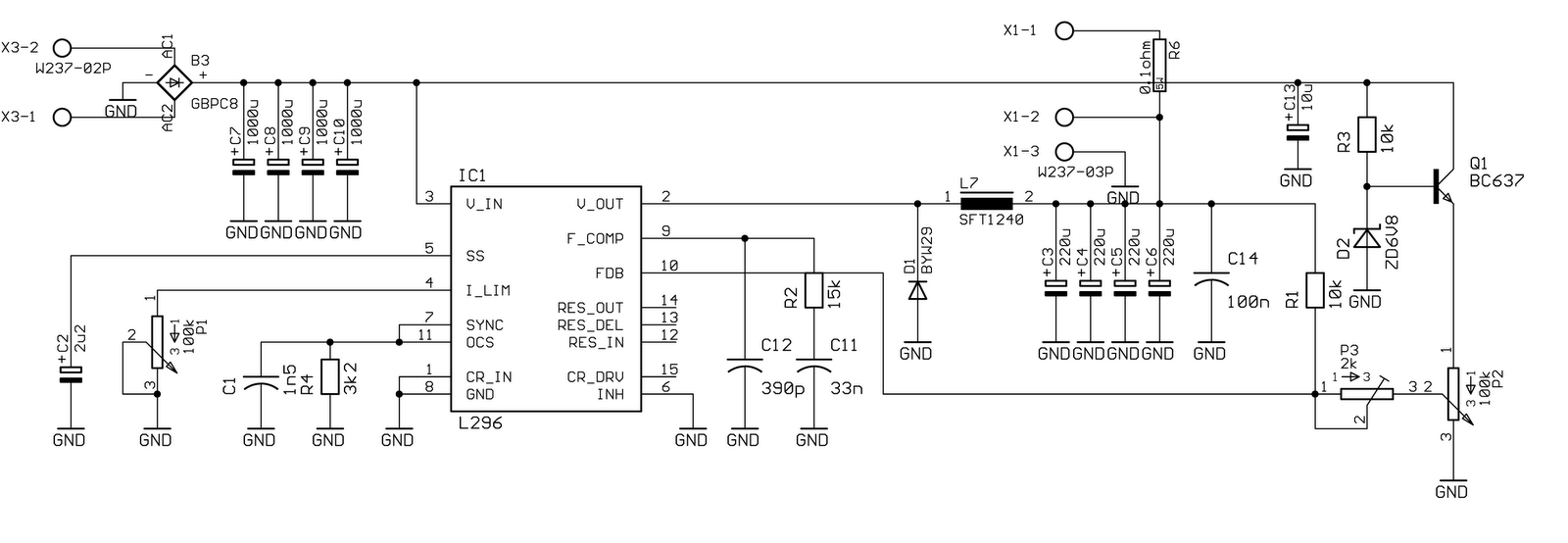
LM317 Adjustable Power Supply

This document outlines the process of constructing an adjustable power supply utilizing the LM317 integrated circuit (IC). The LM317 is highly versatile, allowing for the creation of a wide variety of compact, high-quality power supply circuits. Various configurations can be implemented for different applications, enhancing existing units with features that significantly improve their durability and performance. Several practical application circuits employing the LM317, as detailed in the National Semiconductor PDF datasheet, are thoroughly explained in this section, accompanied by relevant circuit diagrams. All discussed circuits require an unregulated input voltage (maximum of 35 Volts) sourced from any standard transformer, bridge rectifier, or capacitor network.
The adjustable power supply circuit based on the LM317 IC is designed to provide a stable output voltage that can be varied according to the user's requirements. The LM317 operates as a linear voltage regulator, capable of delivering output currents up to 1.5 A with proper heat sinking. The output voltage can be adjusted between 1.25 V to 37 V, making it suitable for powering a wide range of electronic devices.
The essential components of the circuit include the LM317 IC itself, two resistors (R1 and R2), and capacitors for input and output stabilization. The resistor values are selected based on the desired output voltage, following the formula:
\[ V_{out} = V_{ref} \left(1 + \frac{R2}{R1}\right) + I_{adj} \cdot R2 \]
Where \( V_{ref} \) is typically 1.25 V, and \( I_{adj} \) is the adjustment pin current, which is usually negligible for practical purposes.
Input capacitors (typically 0.1 µF ceramic) are placed close to the input pin of the LM317 to filter out high-frequency noise, while an output capacitor (usually 10 µF electrolytic) is used to improve transient response and stability. A heat sink is necessary for the LM317 to dissipate heat generated during operation, especially when there is a significant voltage drop between the input and output.
The circuit can be powered by an unregulated DC voltage source, such as a transformer with a bridge rectifier. The maximum input voltage should not exceed 35 V to prevent damage to the LM317. The power supply's design allows for flexibility and adaptability, making it suitable for various applications, including powering microcontrollers, sensors, and other low to medium power electronic devices.
In summary, the LM317 adjustable power supply circuit is a robust solution for providing a regulated output voltage tailored to specific needs, combining simplicity in design with versatility in application.Here`s how to build your own adjustable power supply based on LM317. The IC LM317 is so versatile that an almost unlimited number of different, small, high grade power supply circuits can be built using it. The configurations can be introduced for different applications for upgrading an existing unit with features that would virtually make it indestructible.
A few useful application circuits using IC LM317, collected from National Semiconductor`s PDF datasheet are meticulously explained in this section with the help of the relevant circuit diagrams. All the circuits discussed below require an unregulated input voltage (max. 35 Volts) from any standard transformer/bridge/capacitor network 🔗 External reference
The adjustable power supply circuit based on the LM317 IC is designed to provide a stable output voltage that can be varied according to the user's requirements. The LM317 operates as a linear voltage regulator, capable of delivering output currents up to 1.5 A with proper heat sinking. The output voltage can be adjusted between 1.25 V to 37 V, making it suitable for powering a wide range of electronic devices.
The essential components of the circuit include the LM317 IC itself, two resistors (R1 and R2), and capacitors for input and output stabilization. The resistor values are selected based on the desired output voltage, following the formula:
\[ V_{out} = V_{ref} \left(1 + \frac{R2}{R1}\right) + I_{adj} \cdot R2 \]
Where \( V_{ref} \) is typically 1.25 V, and \( I_{adj} \) is the adjustment pin current, which is usually negligible for practical purposes.
Input capacitors (typically 0.1 µF ceramic) are placed close to the input pin of the LM317 to filter out high-frequency noise, while an output capacitor (usually 10 µF electrolytic) is used to improve transient response and stability. A heat sink is necessary for the LM317 to dissipate heat generated during operation, especially when there is a significant voltage drop between the input and output.
The circuit can be powered by an unregulated DC voltage source, such as a transformer with a bridge rectifier. The maximum input voltage should not exceed 35 V to prevent damage to the LM317. The power supply's design allows for flexibility and adaptability, making it suitable for various applications, including powering microcontrollers, sensors, and other low to medium power electronic devices.
In summary, the LM317 adjustable power supply circuit is a robust solution for providing a regulated output voltage tailored to specific needs, combining simplicity in design with versatility in application.Here`s how to build your own adjustable power supply based on LM317. The IC LM317 is so versatile that an almost unlimited number of different, small, high grade power supply circuits can be built using it. The configurations can be introduced for different applications for upgrading an existing unit with features that would virtually make it indestructible.
A few useful application circuits using IC LM317, collected from National Semiconductor`s PDF datasheet are meticulously explained in this section with the help of the relevant circuit diagrams. All the circuits discussed below require an unregulated input voltage (max. 35 Volts) from any standard transformer/bridge/capacitor network 🔗 External reference





